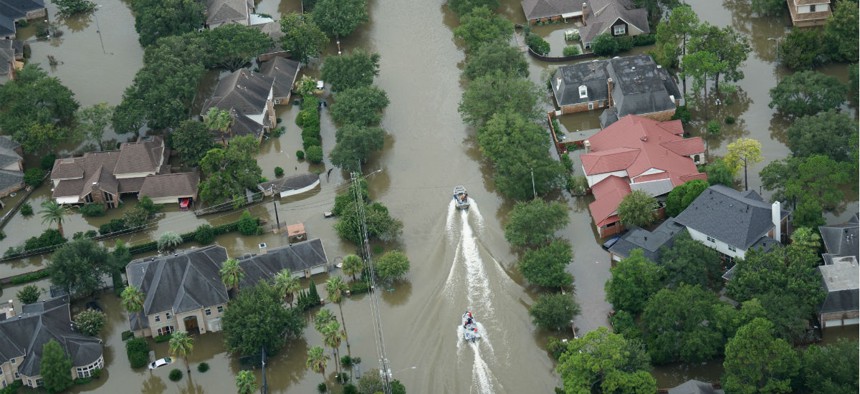OPM Treads Water on Retirement Backlog, Harvey Response Continues, and More
A weekly round-up of pay and benefits news.
The Office of Personnel Management effectively made no progress in its handling of the backlog of federal retirement claims in August, although the number of new claims declined.
According to statistics released Tuesday, the backlog of retirement claims at the end of August was 17,125, slightly higher than the 17,091 reported at the end of July. But the number of claims OPM received dropped from 10,070 in July to 7,136 last month.
The percentage of claims processed within 60 days since last October improved slightly, from 55 percent in July to 57 percent last month. The total number of claims processed last month was 7,102, a modest decrease from the 7,509 completed in July.
Last month, OPM officials confirmed that President Trump’s temporary hiring freeze, implemented in January and lifted in May, had an impact on the agency’s ability to keep up with demand. The new data was released just days after Trump nominated Jeff T. H. Pon, a longtime human resources professional, to be director of the agency.
Meanwhile, federal agencies are continuing to help with disaster relief efforts in the aftermath of Hurricane Harvey and the approach of Hurricane Irma, which could make landfall in Florida this weekend. Jack Corrigan reports that the Thrift Savings Plan last week gave federal workers impacted by Harvey the temporary ability to make “financial hardship” withdrawals, allowing employees with certain medical, legal or property expenses access to money in their retirement accounts.
“TSP also waived the rule barring employees from contributing to their investments in the six months after making a withdrawal, meaning employer contribution matching still applies.
All Harvey-related withdrawal requests must be submitted to TSP by Jan. 24 with distribution dates before Jan. 31. Employees must withdraw at least $1,000 and cannot request an additional withdrawal for at least six months.
Such changes are common after disaster strikes. TSP implemented similar rules in the aftermaths of hurricanes Matthew and Sandy, and also during the government shutdown in October 2013.”
Additionally, the Federal Employee Education and Assistance Fund, an independent nonprofit that provides emergency financial assistance and scholarships to civilian federal employees and their families, is offering disaster relief grants for federal employees affected by the storm. OPM reported last week that nearly 60,000 federal workers live or work within Harvey’s path.
Eligible employees can receive up to $500 through the program. Applicants must be full- or part-time permanent federal civilian or postal employees who have been with the federal government for at least one year, or a member of the National Active and Retired Federal Employees Association. Grant funds can be used to pay for major home repairs that aren’t covered by insurance, temporary housing or beds that were destroyed in the storm.
In retirement news, First Command Financial Services had a warning for service members who use the Defense Department’s online blended retirement system calculator. Without a strong understanding of personal finance, military personnel “could mistakenly generate inflated results” of their retirement annuities.
The calculator was released in June and is intended to help current military service members decide whether to opt into the new blended retirement system, which launches next year and offers service members an employer match of between 1 percent and 5 percent to the federal government’s 401(k)-style Thrift Savings Plan in exchange for a less generous annuity calculation if they reach the 20-year benchmark that qualifies them for pension benefits.
Officials with the company, which offers financial advice to military families, said that service members without a strong grounding in personal finance should consult an expert before using the calculator.
“The DoD’s calculator is a powerful tool, but one that may be difficult for the average service member to effectively employ without the guidance of a knowledgeable financial coach,” said chairman and CEO Scott Spiker. “During our detailed analysis, we found that effective use of the tool requires an advanced understanding of financial planning principles. Users who lack a strong grounding in personal finance could mistakenly generate inflated results that they won’t see in real life.”
First Command commissioned consulting firm Sentient Decision Science to analyze the calculator, which found that the calculator’s default rate of return—the C Fund’s average of 7-percent per year—could overestimate a service member’s TSP growth.
“Our concern is that the DoD is utilizing a long-term rate of return that is notably higher than what we have seen generated by the funds it will be automatically selecting for new enrollees,” Spiker said. “For service members who expect to remain invested in one of the lifestyle funds, the calculator’s 7 percent default rate may overestimate long-term investment performance and give some service members an inflated sense of the eventual size of their retirement assets.”




